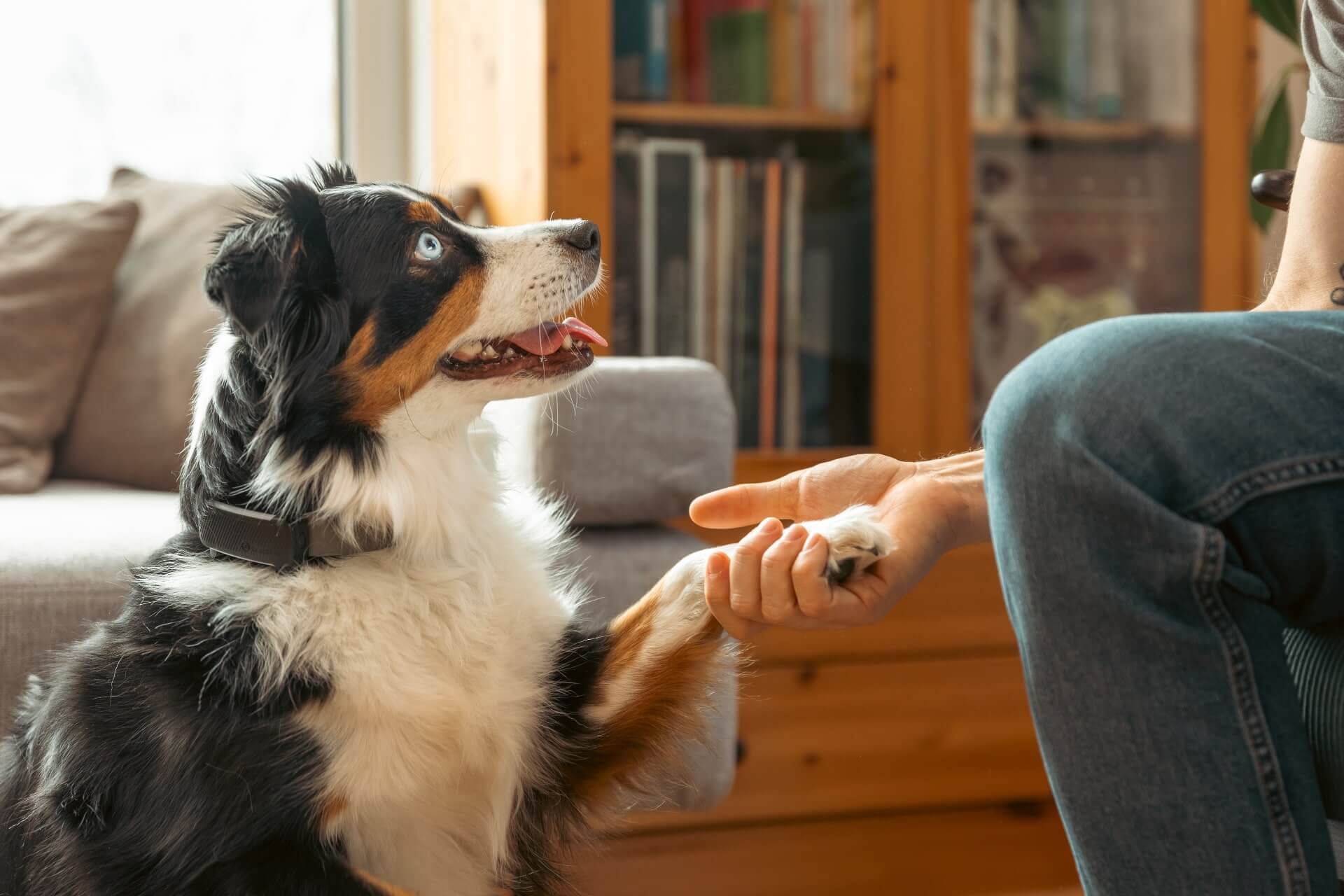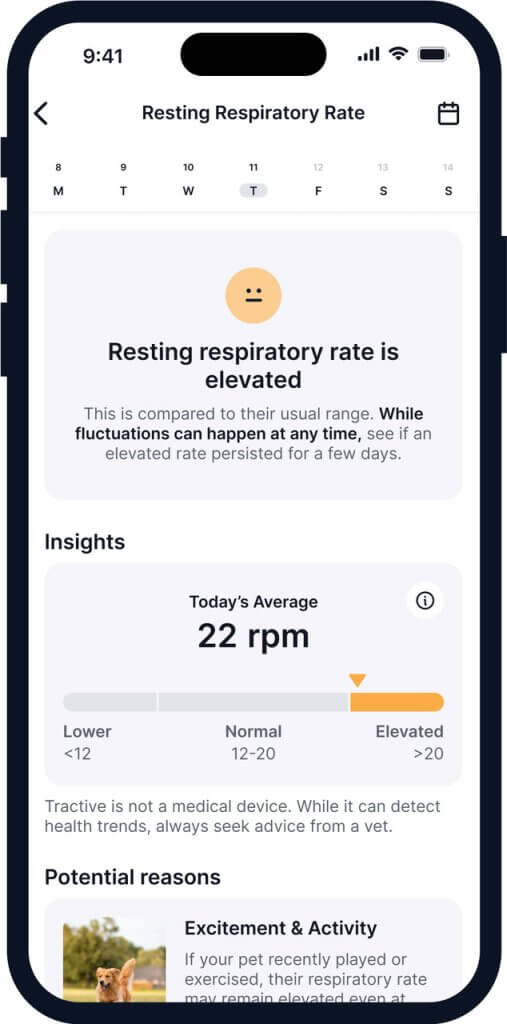 Approved by Dr. Dwight Alleyne, DVM
Approved by Dr. Dwight Alleyne, DVM Why Is My Dog Sneezing So Much? (And How To Help?)
Dogs tend to explore the world, nose-first - which can open them up to a bit of sneezing trouble, if they're unlucky! Here are all the reasons why your dog is sneezing so much - and what steps you can take right away.

Just like us, even our four-legged buddies can fall prey to the seasonal sniffles. But if you’re finding yourself wondering – why is my dog sneezing so much out of nowhere? – it can be a concerning sign. (Especially if it persists.) Let’s dive right into the reasons behind sneezing in dogs, when you should head to your vet, and how you can monitor your dog’s vital signs, including their breathing rate.

Always know your buddy is healthy & safe
Read moreWhy is my dog sneezing? The main causes
Now the occasional sneeze or two is (usually) not a cause for concern. In fact, dogs might even sneeze out of excitement or in the middle of playtime – like to show another playmate that they’re friendly and not a threat.1
Besides, sneezing actually helps your dog’s nose clear out any irritants – or even something that might be stuck inside. So it plays an important role in keeping your buddy healthy, even if it doesn’t sound like it!
But as it turns out, the reasons your dog might be sneezing could range from completely harmless to more serious health issues. With common culprits including:
Airborne irritants (which might trigger allergies)
Your dog’s sense of smell is nothing short of a superpower – it’s at least a million times more sensitive than ours. So watch out for strong scents in your home environment – like:
- Air fresheners,
- Scented candles,
- Deodorants and perfumes,
- Cleaning products,
- and even some hair sprays – all of which can trigger a sneezing fit.
(Besides other common culprits like smoke and dust.)
Seasonal allergens
Just like us, your buddy can also run into some seasonal allergens – both indoors and outdoors. Which, if your dog’s developed an allergy, might also turn up as watery eyes, and even coughing. (Meaning, their immune system considers it a threat and is now on “fight mode.”) Including:
Spring | Heavy pollen in the air, which can trigger some major sneezing in dogs – especially if your buddy’s already allergic to it. LIkewise, if your dog spends time outdoors, playing in grass might trigger some sneezing from any pollen there. |
Summer | If your dog is allergic to bug bites, it might trigger some sneezing. Watch out for mosquitoes and bees when you’re both out enjoying the sun. |
Fall | Fallen leaves, humid air, mold, and even some mushrooms and fungi might irritate your buddy’s respiratory system in the crisp fall months. Likewise, some plants like ragweed still release pollen during fall months, which can lead to sneezing. Some fleas can survive even up to the fall months – and cause your buddy a world of discomfort if they’re allergic to flea bites! |
Winter | Staying indoors can mean your heating system stirs up some dust, which can also trigger some sneezing – and possibly a dust mite infection. |
Foreign objects
Even if your dog is more of a home-buddy – they’re still going to be sniffing around and getting their nose up just about any nook, cranny, and dusty corner they can find. Which means, it’s possible their sneezing might be an attempt to get rid of:
- Grass,
- Dust,
- Dirt,
- Sticks,
- Pebbles,
- Or even small bugs stuck in their nasal passages!
In fact, nasal mites are most common if your buddy tends to dig around or rub their nose in dirt. Their bites often irritate your poor buddy’s nostrils and lead to inflammation.
⚠️ So if your dog is suddenly sneezing out of nowhere – take note. It could just be something stuck in their nose which they’re trying to release. If it persists or if you see other, alarming signs like thick or bloody discharge – drop by your vet for a checkup.
Infections
If your buddy’s picked up a viral, bacterial, or even fungal infection, it can wreak some havoc on their respiratory system. Which could include health conditions like:
- Upper respiratory infections
Including kennel cough and canine influenza, which your dog can pick up from other dogs at shelters or parks. These often spread through nose droplets. - Fungal infections
Especially from moist and/or rural areas bordering woodland. Some mushrooms can be fatally toxic to dogs, so watch out! - Canine distemper
Which is a serious viral infection that includes sneezing, coughing, and even some gastrointestinal symptoms. - Pneumonia
Which can develop from both bacterial and viral infections. - Rhinitis or sinusitis
Which can result from bacterial or fungal infections, and can lead to an inflammation of your dog’s nose or sinuses.
Watch out for symptoms like excessive nasal discharge and incessant sneezing – and get your dog to a vet right away.
Other medical conditions
Besides infections and allergies, here are some other medical conditions that can trigger sneezing as a symptom:
- Nasal tumors,
- Other respiratory parasites,
- Asthma – especially if your dog is breathing weirdly along with sneezing
- Dental diseases, especially from infected gums or abscesses
- Tracheal collapse, especially in small or toy dog breeds
- Autoimmune conditions, like idiopathic rhinitis, which can cause chronic inflammation of the nasal passages.
In some cases, your dog’s breed can play a role in how much at risk they are for respiratory problems. Brachycephalic dog breeds like Pugs, Bulldogs, and Boxers tend to have short nasal passages and flat faces. This can make it difficult for them to breathe properly – and make it more likely they’ll sneeze, especially when excited or overexerted. These dogs might also be vulnerable to reverse sneezing – as well as smaller dog breeds in general.
Why is my dog reverse sneezing? And is it cause for concern?
Not always – but it could be, depending on how severe and frequent it is. Reverse sneezing is when your dog suddenly inhales sharply – kind of like they’re sucking back in a sneeze. They might breathe suddenly and repeatedly through their nose, almost sounding like honking or if they’re having trouble breathing.
In general, reverse sneezing isn’t always a cause for concern. Your dog might even reverse sneeze out of excitement, on some occasions. But this condition could also be triggered by irritants in the air or inflammation in your dog’s nasal passages. On other occasions, reverse sneezing helps your dog clear out something irritating the roof of their mouth. So keep an eye out for how frequent their reverse sneezing is – and take a video for your vet for your checkup.
When to head to your vet
In general, a bit of sneezing really isn’t a reason to panic. But it does count as an emergency if you notice your dog experiencing:
- Excessive sneezing,
- Excessive itching or licking themselves,
- Nasal discharge that’s thick and/or bloody,
- Nasal swelling,
- Coughing,
- A reduced appetite, seeming more reluctant to eat or drink
- Lethargy,
- Fever
How your vet might diagnose & treat your dog’s sneezing
Your vet will most likely begin by checking your dog’s nose and throat to rule out any obvious causes of sneezing. (Like foreign objects.) In more severe cases, they might recommend an X-ray or rhinoscopy, where they’ll use a tiny camera to check inside your dog’s nasal passages. Your vet might also suggest testing your dog for any allergies – to environmental allergens, but also the commercial dog food you might be feeding them.
Based on what’s causing your dog’s sneezing, your vet might recommend:
- Nasal drops or sprays to help clear out your buddy’s nostrils,
- Decongestants, to help get rid of any blocking,
- Allergy treatments, including antihistamines or specific shots
- Antibiotics or antivirals to deal with any secondary infections,
- Corticosteroids, in case your buddy’s sneezing is caused by inflammation or tumors
How you can care for your buddy at home
As your dog gets better from their treatment, here are some steps you can take to create a supportive home environment for them:
- Do a thorough deep clean indoors to get rid of any indoor irritants that might be triggering your buddy’s sneezing. Which can include dust and smoke, but also cleaners or air fresheners.
- Wipe down your buddy extra thoroughly after your walks outdoors to get rid of any pollen. (And don’t skip on their allergy medication!)
- Use a humidifier near your dog’s sleeping area to help with any congestion.
- Let your dog lie on the bathroom floor with a hot shower running. This can also help with any symptoms as they get better.
- Avoid using any over-the-counter medications designed for dealing with colds or sneezing in humans. Many of these aren’t the safest for dogs to ingest and might actually worsen their health!
- Follow your vet’s instructions to a T, for the full course of treatment. (Yes, even if your dog seems to be getting better.)
- Keep an eye out for any change in your dog’s symptoms.
Where a smart dog tracker can help
Frequent sneezing in dogs can be caused by anything from seasonal allergies to respiratory infections – and it’s not always easy to spot the difference. That’s where a smart dog tracker like the Tractive GPS can offer peace of mind and practical support.

Strapped to your dog’s collar, here’s how it helps:
- Understand behavioral changes
With your tracker’s built-in motion detector, you can monitor changes in your dog’s activity and sleep patterns. (Which often accompany health issues like allergies or illness.) - Get alerts when something’s off
If there’s a drop in your dog’s activity or a change in their sleep quality, you’ll get a Health Alert – so you can take action quickly. More often than not, these could be signs of a health issue. - Spot potential health issues early
From your tracker’s Health Monitoring features, you can keep track of your dog’s vital signs. Including their breathing and heart rate – which can help you detect signs of stress, respiratory trouble, or allergic reactions before they escalate.

- Keep your dog out of allergen-prone areas
With real-time GPS tracking, you’ll know exactly where your dog wanders around throughout the day – so you can steer them away from high-risk zones like pollen-riddled fields or moldy woods. - Feel confident in your dog’s wellbeing – anytime, anywhere
With all this data accessible in one app, you’ll always know how your dog is doing, whether you’re at home or away. Better yet, it also means a more productive conversation with your vet.
By combining health insights with live location tracking, Tractive gives you the tools to support your dog through sniffles, sneezes, and beyond.

Get health alerts for your dog
Our pups can’t always tell us if something’s wrong. But if their tracker detects unusual changes in their routine, you’ll get an alert, helping you catch potential issues early.
And if you’ve liked this post, share it with a friend or a loved one – and let’s help build a safer, kinder world for our furry friends together.
Your furry friend’s health and wellbeing means as much as to us as it does to you. So we’ve made it a priority to only share medically-relevant content on our blog.
This post was checked, double-checked, and medically verified by Georgia-based vet, Dr. Dwight Alleyne.

Originally from Long Island, New York, Dr. Alleyne began his career at a no-kill animal shelter before becoming a licensed veterinary technician. He graduated from Cornell University Veterinary College in 2006 and completed an internship at Purdue University.
Now practicing in Georgia, Dr. Alleyne specializes in soft tissue surgery and ultrasounds. He also writes pet health articles on his website, “The Animal Doctor Blog” (www.anmldrblog.com).



